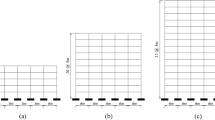Abstract
Many urban areas are located in regions of moderate seismicity and are subjected to strong wind. Buildings in these regions are often designed without seismic provisions. As a result, in the event of an earthquake, the potential for damage and loss of lives may not be known. In this paper, the performance of a typical high-rise building with a thick transfer plate (TP), which is one type of building structure commonly found in Hong Kong, is assessed against both earthquake and wind hazards. Seismic-and wind-resistant performance objectives are first reviewed based on relevant codes and design guidelines for high-rise buildings. After a brief introduction of wind-resistant design of the building, various methodologies, including equivalent static load analysis (ESLA), response spectrum analysis (RSA), pushover analysis (POA), linear and nonlinear time-history analysis (LTHA and NTHA), are employed to assess the seismic performance of the building when subjected to frequent earthquakes, design based earthquakes and maximum credible earthquakes. The effects of design wind and seismic action with a common 50-year return period are also compared. The results indicate that most performance objectives can be satisfied by the building, but there are some objectives, such as inter-story drift ratio, that cannot be achieved when subjected to the frequent earthquakes. It is concluded that in addition to wind, seismic action may need to be explicitly considered in the design of buildings in regions of moderate seismicity.
Similar content being viewed by others
References
Applied Technology Council (1996), “Seismic Evaluation and Retrofit of Concrete Buildings (ATC-40),” Vol. 1, Report No. SSC 96-01, ATC: Redwood City, CA.
Bentz E (2001), Response 2000, http://www.ecf.utoronto.ca/%7Ebentz/r2k.htm.
Bertero RD and Bertero VV (2002), “Performance-Based Seismic Engineering: The Need for A Reliable Conceptual Comprehensive Approach,” Earthquake Engineering & Structural Dynamics, 31(3): 627–652.
Building Department (2004a), Code of Practice on Wind Effects in Hong Kong, Hong Kong SAR.
Building Department (2004b), Hong Kong Code of Practice for Structural Use of Concrete, Hong Kong SAR.
CSI (2005), ETABS, Extended 3D Analysis of Building Systems, Computers and Structures, Inc., CA, USA.
EEFIT (1991), “The 1989 Newcastle Australian Earthquake, a Field Report by EEFIT (Earthquake Engineering Field Investigation Team),” Institution of Structural Engineers (UK).
Federal Emergency Management Agency (1997), NEHRP Guidelines for the Seismic Rehabilitation of Buildings (FEMA Publication 273), Washington, DC.
Geotechnical Control Office (1991), Review of Earthquake Data for the Hong Kong Region, GCO Publication, No. 1/91, Civil Engineering Services Department, Hong Kong.
Ghobarah A (2001), “Performance-Based Design in Earthquake Engineering: State of Development,” Engineering Structures, 23(8): 878–884.
JGJ 3-2002 (2002), Chinese Technical Specification for Concrete Structures of Tall Building, Beijing, China.
JGJ 99-98 (1999), Chinese Technical Specification for Steel Structure of Tall Buildings, Beijing, China.
Li JH (2003), “Seismic Drift Assessment of Buildings in Hong Kong with Particular Application to Transfer Structures,” Ph.D. thesis, Civil Engineering Dept., University of Hong Kong, Hong Kong.
Scott DM, Pappin JW and Kwok MKY (1998), “Seismic Design of Buildings in Hong Kong,” Proc. of the International Workshop on Earthquake Engineering for Regions of Moderate Seismicity, ed. Lam E S S and Ko J M, Hong Kong SAR, pp. 79–106.
SEAOC Vision 2000 Committee (1995), Performance-based Seismic Engineering of Buildings, Vols. I and II: Conceptual Framework, Structural Engineers Associations of California, Sacramento, CA.
Su RKL, Chandler AM, Lee PKK, To AP and Li JH (2003), “Dynamic Testing and Modeling of Existing Buildings in Hong Kong,” Transactions of Hong Kong Institution of Engineers, 10(2): 17–25.
Su RKL, Chandler AM, and Li JH (2002), “Seismic Assessment of Transfer Plate High Rise Buildings,” Structural Engineering and Mechanics, 14(3): 287–306.
Xu YL, Ko JM, Chau KT, Lam SS and Wong YL (2001), “Research of Earthquake Engineering in Hong Kong: Current Status and Future Challenge,” in Earthquake Engineering Frontiers in the New Millennium, ed. Spencer & Hu (eds), A.A. Balkema Publishers, pp.77–99.
Author information
Authors and Affiliations
Corresponding author
Additional information
Supported by: Financial Support from Hong Kong Polytechnic University Under Grant No. G-YX76
Rights and permissions
About this article
Cite this article
Zhou, X., Xu, Y.L. Multi-hazard performance assessment of a transfer-plate high-rise building. Earthq. Eng. Eng. Vib. 6, 371–382 (2007). https://doi.org/10.1007/s11803-007-0780-9
Received:
Accepted:
Issue Date:
DOI: https://doi.org/10.1007/s11803-007-0780-9




